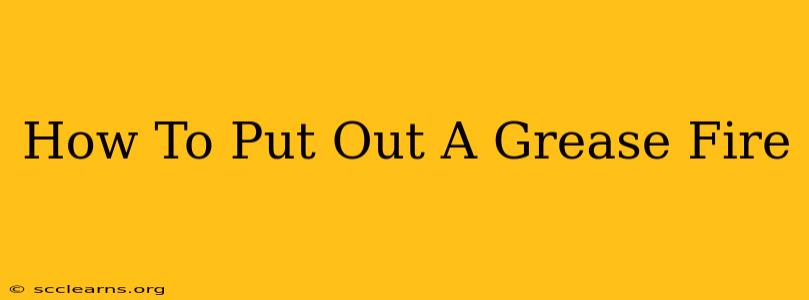A grease fire is a terrifying experience. The flames leap high, spreading quickly, and the intense heat can cause serious burns. Knowing how to put out a grease fire is crucial for kitchen safety and can prevent significant damage and injury. This guide provides a step-by-step approach to handling this dangerous situation effectively.
Understanding Grease Fires
Before we dive into extinguishing the fire, understanding what causes a grease fire is key to preventing them in the future. Grease fires occur when cooking oil or grease reaches its ignition point. This usually happens when the oil is overheated, often due to:
- High heat: Cooking at too high a temperature.
- Overfilled pans: Too much oil in the pan leaves less room for heat dissipation.
- Leaving the kitchen: Never leave cooking oil unattended, especially when it's hot.
- Adding water to hot oil: This is a common mistake that can cause a rapid escalation of the fire. Never do this!
How to Extinguish a Grease Fire: The Do's and Don'ts
The most important thing to remember is to stay calm. Panicking will only make the situation worse. Here's a clear, step-by-step guide:
What NOT to do:
- Don't use water: Water and hot oil are a dangerous combination. The water will instantly turn to steam, causing the hot oil to splatter violently and spread the fire.
- Don't move the pan: Moving a burning pan risks spilling hot oil and spreading the flames.
- Don't use flour or baking soda: While sometimes suggested, these methods are unreliable and can potentially make the fire worse.
- Don't use a fire extinguisher inappropriately: Using the wrong type of extinguisher can be ineffective or even dangerous.
What TO do:
-
Turn off the heat source: Immediately switch off the stovetop or oven. This will stop the supply of heat fueling the fire.
-
Cover the pan: This is the most effective method for small grease fires. Carefully and slowly slide a lid over the pan to smother the flames. Make sure the lid fits snugly. Leave it on until the fire is completely out and the pan is cool.
-
Use a fire extinguisher (if necessary): If the fire is large or spreading beyond the pan, use a Class B or ABC fire extinguisher. Remember to aim at the base of the flames and sweep from side to side. This should be a last resort if covering the pan isn't effective.
-
Evacuate if necessary: If you can't control the fire safely, evacuate your home immediately and call the fire department. Your safety is paramount.
Prevention is Key: Safe Cooking Practices
Preventing a grease fire is always better than dealing with one. Here are some simple steps to ensure kitchen safety:
- Use the right amount of oil: Don't overcrowd your pan with oil.
- Maintain a moderate cooking temperature: Avoid using excessively high heat.
- Never leave cooking oil unattended: Always stay in the kitchen while cooking.
- Keep a fire extinguisher handy: Make sure it's readily accessible and you know how to use it.
- Clean up spills immediately: Oil spills can easily ignite.
Knowing how to put out a grease fire is a vital life skill. By following these steps and practicing safe cooking habits, you can significantly reduce the risk of a kitchen fire and keep yourself and your family safe. Remember, safety first!

